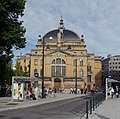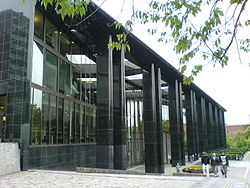Oslo
Oslo is the capital city of Norway. It is Norway's largest city, with a population of 709,037 people in 2023.[2][3][4] The area near the city has a total population of 1,588,457.[5][6] The city government of Oslo and the county are the same thing.
City | |
| Area | |
| • City | 480 km2 (190 sq mi) |
| • Land | 454.20 km2 (175.37 sq mi) |
| • Water | 26.64 km2 (10.29 sq mi) |
| Population | |
| • City | 709,037 |
| • Urban | 1,064,235 |
| • Metro | 1,588,457 |
| Time zone | UTC+1 (CET) |
| • Summer (DST) | UTC+2 (CEST) |
Oslo today
The city is a big place for economy and culture. A lot of important institutions are in Oslo. Some of these are the Norwegian government and parliament, the University of Oslo and Ullevål Stadion, which is the stadium of Norway's soccer team. The city also has many museums, theaters and concert venues. Some good cultural places are Frogner Park, the Oslo Opera House, the National Museum and the National Theatre. Travelling inside the city is easy with public transportation. Using tram, subway and bus is easy.
Oslo is a very expensive city, with high prices in bars and restaurants, as well as high prices for houses and apartments.
Oslo has a humid continental climate (Dfb in the Koeppen climate classification).
History
The Saga of Norwegian Kings (written by Snorre Sturlason) says that king Harald III Sigurdsson founded Oslo around 1048. Recent excavations have found Christian graves from before 1000. Because of these two facts, Oslo celebrated its 900-year anniversary in 1950 and its 1000-year anniversary in 2000.
One of the more famous landmarks in Oslo is Akershus Fortress. It was first built around 1290. Oslo was destroyed in fire in 1624,[7][8] and the fortress was rebuilt closer to Akershus Fortress by the order of King Christian IV of Norway. The king gave the new city the name Christiania, which later also written as Kristiania.[9][10] In 1925, the name of the city was changed back to Oslo.[8][9]
Oslo Media
Frogner Park's Vigeland installation in Oslo
Fjordbyen is a large construction project in the seaside of central Oslo, stretching from Bygdøy in the west to Ormøya in the east. Some areas include: Bjørvika, Aker brygge, Tjuvholmen, and the central station area.
Detail of modern architecture at Aker Brygge
Office buildings and apartments in Bjørvika, part of the redesign of former dock and industrial land in Oslo known as the Barcode Project
Related pages
References
- ↑ "Arealstatistikk for Norge". Kartverket.no. Kartverket. 16 October 2014. Archived from the original on 19 April 2016. Retrieved 22 August 2023.
- ↑ 2.0 2.1 "Population, 1 January 2016". Statistics Norway. 19 February 2016. Archived from the original on 19 April 2016. Retrieved 22 August 2023.
- ↑ 3.0 3.1 "Population and land area in urban settlements, 1 January 2014". Statistics Norway. 9 April 2015. Archived from the original on 16 October 2015. Retrieved 22 August 2023.
- ↑ 4.0 4.1 "Population and population changes, Q2 2015". Statistics Norway. 20 August 2015. Archived from the original on 16 October 2015. Retrieved 22 August 2023.
- ↑ 5.0 5.1 regionaldepartementet, Kommunal- og (9 May 2003). "St.meld. nr. 31 (2002–2003)". Regjeringen.no (in norsk). Archived from the original on 6 December 2017. Retrieved 22 August 2023.
- ↑ 6.0 6.1 "Folketalet ved nyttår var 5 258 000" (in nn-NO). ssb.no. https://www.ssb.no/befolkning/statistikker/folkemengde/aar-per-1-januar/2017-02-23. Retrieved 22 August 2023.
- ↑ Aftenposten, 12 October 2014, p. 15.
- ↑ 8.0 8.1 "Han har kartlagt Christianias karthistorie". 8 December 2014. Archived from the original on 13 January 2016. Retrieved 23 August 2023.
- ↑ 9.0 9.1 "Oslo – historie". 3 August 2018. Archived from the original on 20 October 2016. Retrieved 23 August 2023.
- ↑ Knut Are Tvedt, red. (2000). «Oslo gate». Oslo byleksikon (4. utg.). Oslo: Kunnskapsforlaget. page. 324. ISBN 82-573-0815-3.















